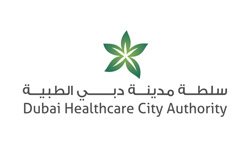News
51-year-old Qatari medical tourist walks again after complex spinal treatment

Tuesday, May 06, 2014
Patient travels - wheel-chair bound, to Dubai Healthcare City; specialists at Dubai Bone and Joint Centre (DBAJ) point to previous misdiagnoses.
Dubai, May 6, 2014:
On the sidelines of the Arabian Travel Market (ATM), the leading travel trade exhibition which opened in Dubai on May 5, 2014, Dubai Healthcare City (DHCC) illustrates medical tourism through the case of a Qatari patient.
For four years, Qatari national Saad Al Sulaiti, 51, suffered from severe pain in both legs. The pain reached a crippling level, confining him to a wheel chair. Several doctors in Qatar focused on treating the limbs. The pain however did not lessen, and Al Sulaiti was desperate for a solution.
The beginning of 2014 brought hope. A leading medical centre in Doha, advised a full body MRI (magnetic resonance imaging) scan.
The results were shocking. The cause of the pain originated in the spine, contrary to the previous diagnoses by doctors in Qatar.
At the centre, the patient was referred to an orthopedic specialist from Dubai Bone and Joint Centre (DBAJ) at Dubai Healthcare City. DBAJ is a comprehensive musculoskeletal centre of excellence in the region, which offers a comprehensive range of procedures.
The reality of the misdiagnoses weighed down Al Sulaiti. His suffering would have been far less had he to receive timely diagnosis and treatment.
With hope to walk again, Al Sulaiti looked up Dubai Healthcare City, a health and wellness destination that brings together a wealth of services in healthcare, medical education and research. His concerns were that of any other medical tourist – safety; accessibility (waiting time, visa, proximity, availability, convenience); accredited facilities; experienced physicians; and exclusive treatment, among others.
He contacted DBAJ, and shared his medical reports.
In March, Al Sulaiti arrived in the UAE – his first visit. He met Dr Zbiggy J. Brodzinsky, Orthopedic Surgeon – Spine at the Dubai Bone and Joint Centre. Accompanied by his family, the Qatari patient was told that he was required to stay in Dubai for two weeks – the duration required for preliminary tests, surgery and follow up.
Following a series of diagnostic tests - MRI for the cervix, thorax and brain, and other related tests, Dr Brodzinsky and his team confirmed the previous misdiagnoses. The patient suffered from monoparesis or loss of voluntary motor function in a single limb in his left leg, acute weakness in his right leg, and the thoracic vertebrae showed abnormalities.
The patient had a herniated (slipped) disk in the thoracic vertebrae. (The medical term for the condition is herniated nucleus pulposus, commonly HNP.) The condition caused back pain and nerve root irritation.
The patient suffered from thoracic spinal canal stenosis or an abnormal narrowing of the spinal canal, which led to chronic back pain. In addition, there was compression in the spinal ligaments.
Al Sulaiti had to undergo a thoracic laminectomy, a surgery performed through the back of the spine to relieve pressure on the nerves or spinal cord. The procedure requires removal of the lamina or the roof of the spinal canal. Once removed, it allows for additional room for the spinal cord and the nerves.
The surgery lasted for five hours. It was a combination of invasive and minimally-invasive surgical techniques. The patient was mobilized within 24 hours of the surgery, and within 48 hours, he was able to walk with minimal assistance.
The Qatari patient has returned to his home country.
Al Sulaiti said, “I am extremely thankful to every single member of the DBAJ team. I can walk again! I am grateful to the Centre’s experience, tailored approach and professionalism. It was great to have my family with me in Dubai through the surgery and the rehabilitation phase.”
Commenting on the case, Dr Brodzinsky said, “The case was complex. The surgery itself was high risk. According to medical literature, thoracic laminectomy is associated with 25-30 per cent mortality. The patient is ecstatic about being mobile again and now looks forward to a productive and good quality of life.”
The doctor added, “The spinal condition was caused by a combination of factors including poor lifestyle – improper posture and sedentary living, and genetics.”
With the increasing availability of advanced logistics and communication services, the dynamics of medical tourism have developed significantly. Today, it is estimated that around 30 to 50 million medical tourists travel abroad annually to seek medical treatment.
Regional dynamics play a crucial role in the flow of medical tourists as a large number of travelers prefer to remain close to home. As such, Dubai has emerged as a key destination for patients in the Middle East.
Medical tourism is approached at a strategic level at Dubai Healthcare City (DHCC), the world’s largest healthcare free-zone located in the heart of the emirate. DHCC was launched in 2002 to meet the demand for high-quality and patient-centered healthcare.
Download the Journey of a Medical Tourist infographic
For more information about Dubai Bone and Joint center visit thier Website